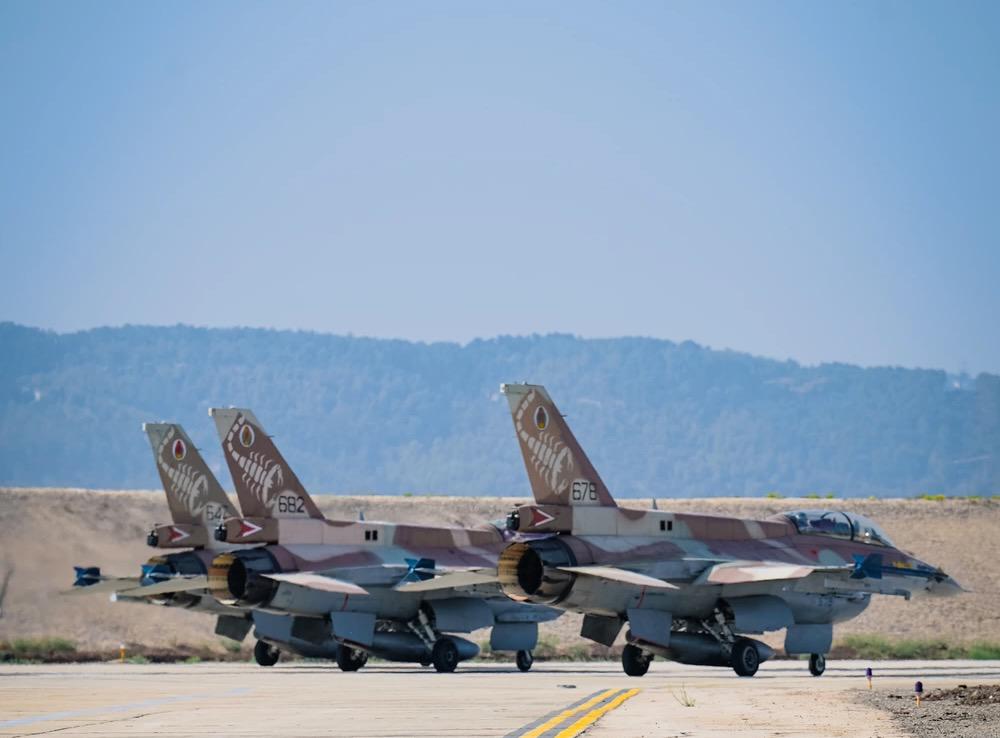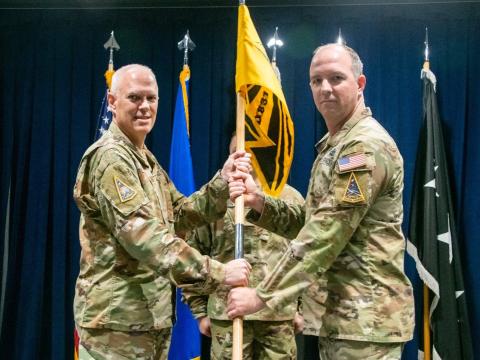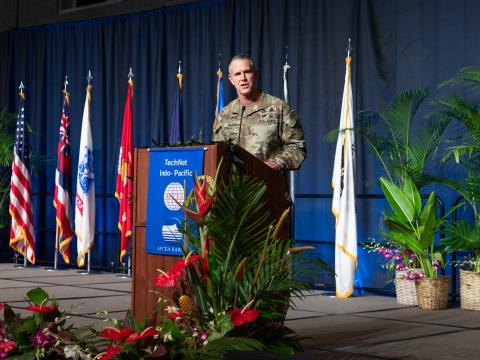An Evolving Air Force Role in the Middle East
The U.S. Air Force Central Command (AFCENT) operating in the Middle East in the U.S. Central Command (CENTCOM) area of responsibility, needs to evolve to meet modern-day near-peer adversarial threats, such as from China, while at the same time keeping at bay risks from Iran and ISIS-related terrorist organizations.
With the shift to the U.S. Indo-Pacific Command as the priority region in terms of the U.S. National Defense Strategy, however, CENTCOM has moved on from its 20-plus-year role as the nexus supporting a counter-terrorism mission and military operations in Afghanistan, Iraq and in other countries.
Even with the U.S. military turning more resources and attention to the Indo-Pacific Region, the Middle East “remains very important from my perspective,” said Lt. Gen. Alexus Grynkewich, commander, Ninth Air Force (Air Forces Central), Shaw Air Force Base, South Carolina; and CENTCOM Combined Forces Air Component commander for Southwest Asia.
“Of course, I'm shaded by where I sit, but we see it as not just a place where we're trying to keep threats to the homeland, like ISIS, at bay or deter Iran as a persistent threat. It is also a very fertile ground for strategic competition with China and Russia.”
But given that AFCENT itself is not performing close-air support to forces on the ground as it once was, this prompts a rethinking of the Air Force’s role, the general said, speaking October 4 to reporters at a Defense Writers Group in Washington, D.C.
“It has put us in a position where we are in need of a mindset shift to think again about how does the Air Force really contribute to major combat operations,” Gen. Grynkewich said. “We need to think about how the Air Force can contribute to those joint operations that are going to have a defeat mechanism against whomever the adversary is. So that's a very different mindset than …. waiting for someone to call you to come and help [provide close air support]. It is about whatever problem I’ve [been given, the Taiwan Straits problem, or Iran] and how do I think about applying the tools of airpower to solve that problem independently in conjunction with the joint force.”
More and more, the service and the U.S. military have to consider China’s activities in the Middle East. “They see the Middle East as a very important region in the world,” Gen. Grynkewich warned. Here, CENTCOM is watching the PRC’s [People's Republic of China's] economic actions and potential for military expansion. Highly dependent on the region, China imports about 50% of its oil and about 33% of its natural gas from Middle East countries. China also wants assured access to shipping lanes, especially to the continent of Africa, with its supply of rare earth minerals.
“We recognize that the long-term existential threat is to the rules-based international order and the challenge that China poses to that rules-based international order,” the commander stated. “We hope that we don't ever get to the point of conflict with China, which is why competition right now is so important to really meet how we're competing with them appropriately. That competition, by definition, in a world where resources are limited, requires a reallocation of focus…. And even though we're not the place where all the money and all the people are going to anymore, that's really a good thing. Our job is to figure out how do we maintain the missions that we need to maintain to allow the NDS [National Defense Strategy] to proceed unabated, with the most reasonable amount of resources to mitigate the risk.”
The United States’ military-to-military relationships with important, long-standing allies in the region, such as Kuwait, Saudi Arabia, Abu Dhabi, and the United Arab Emirates, remain strong, Gen. Grynkewich shared.
The nature of Russia’s activities, meanwhile, has shifted in the last few weeks regarding Syria. The commander said that the pace of Russian activity has remained relatively constant—the Russian Air Force, the VVS, does continue to fly in the airspace over the al-Tanf garrison and continues to intercept U.S. MQ-9 Reaper aircraft, but he has seen “some favorable,” de-escalatory shifts in their behavior over the last month.
“In the past, I would have told you that I was very concerned about Russian air-to-ground aircraft armed with air-to-ground weapons, flying directly over our forces [in Syria],” Gen. Grynkewich explained. “That's now very rare and, in fact, hasn't happened for several weeks. They are still flying the airspace, but not directly overhead our forces.”
In addition to a shifting military role, AFCENT is bringing more innovation right into operations, especially through its Task Force 99.
Established in October 2022 to be the aerial component of the Navy’s Task Force 59 and the Army’s Task Force 39, Task Force 99 is inserting unmanned systems, artificial intelligence and decision tools into combatant command operations. Now led by Col. Robert Smoker, who took over from Lt. Col. Erin Brilla in February, and headquartered at Al Udeid Air Base, Qatar, Task Force 99 harnesses commercial off-the-shelf (COTS) technology, providing flexible, low-cost solutions for CENTCOM missions, the general reported.
“I've broadly given Task Force 99 three main problems to look at,” Gen. Grynkewich explained. “One of them is increasing our air domain awareness, which basically means our ability to sense the things that affect our ability to operate in the air, whether that is surface air missiles or [other] airplanes. Number two is to help us figure out how we can find hard targets in an intelligence surveillance reconnaissance-type mission. And then the third is [what] I call imposing dilemmas on the adversary.”
![With different missions sets in the Middle East, the U.S. Air Force is evolving its role past that of its traditional counter-terrorism role. “We need to think about how the Air Force can contribute to those joint operations that are going to have a defeat mechanism against whomever the adversary is. So that's a very different mindset than …. waiting for someone to call you to come and help [provide close air support],” says Lt. Gen. Alexus Grynkewich, commander, Ninth Air Force (Air Forces Central).](/sites/default/files/styles/image_caption/public/2023-10/Grynkewich_Alexus_LtGen_USAF_AFCENT_Cmdr_4Oct2023_DWG_event.png?itok=H8efeCgq)
As part of the third problem set to impose dilemmas on the adversary, the task force is examining the possibility of one-way kinetic attacks, such as the so-called Kamikaze drones that have been used against the United States. “That is certainly something that we're looking at,” he said. “These are just low, slow cruise missiles with different payloads. But it also could include something that can do spectrum warfare, or something that just harasses the adversary, etc. There's a number of different things that we're looking at.”
AFCENT is working on the corresponding concepts of operations needed to implement the ‘impose dilemmas’ options, but already, warfighters are using Task Force 99 elements for intelligence, surveillance and reconnaissance (ISR) and other missions. For example, while the traditional MQ-9 Reaper unmanned aerial vehicle is a steadfast, highly developed ISR capability, it does have limitations—sometimes a lack of visibility below the cloud deck or higher necessary flight altitudes. The Task Force is pulling in COTS capabilities adapted for military use that are proving to be effective alternatives, such as 3D-printed unmanned aerial vehicles.
“Using smaller, more bespoke capabilities that fly lower and under the weather, we've been able to use high-resolution cameras and get information on things that might be a threat to us,” Gen. Grynkewich said. We have a new 3D-printed drone that we have created called Kestrel. We can make this thing for about 2,500 bucks (and that includes all the avionics), and it can go roughly 100 kilometers, so not a huge range, but something that can be relevant on the battlefield. It gives us some optionality with platforms to think about how we might use them.”
The service is working with five other countries as part of the task force. “As we look at different technologies and in conjunction with our partners, things that solve their particular problems, our problems, one of the things that the task force can do is, it does a really good job of surveying the innovative space for technologies, bringing them into a realistic combat environment, austere environment, a hot environment, human environment and testing them,” the commander added.
To gain the ability to scale, though, and produce more and more solutions across the region or globe, the task force will leverage the so-called Department of Defense Replicator program, managed by Deputy Defense Secretary Kathleen Hicks and Adm. Christopher Grady, the vice chairman of the Joint Chiefs of Staff.
“I think what Replicator will do is help us make that shift,” Gen. Grynkewich said. “It will help us understand a couple of different sides of this, including the production side of it. And can companies that are offering these off-the-shelf [solutions] scale production to meet our requirements, and what would that look like? And then we'll also learn what kind of training [that] we need. And what kind of airmen do we need operating these systems.”
AFCENT will work to tie in capabilities to Replicator with which the command has already found proven utility. “Let's now see how that could scale,” the commander said.




Comments